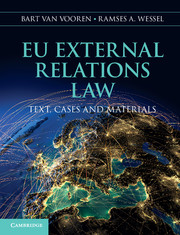Book contents
- Frontmatter
- Contents
- Table of cases
- Table of instruments and legislation
- Preface
- Acknowledgements
- List of abbreviations
- 1 The EU as a global legal actor
- 2 Instruments of EU external action
- 3 Existence of EU external competence
- 4 Nature of EU external competence
- 5 Scope and choice of EU external competence
- 6 The duty of cooperation
- 7 EU law and international law
- 8 The EU and international institutions
- 9 Common Commercial Policy
- 10 EU development policy
- 11 Common Foreign and Security Policy
- 12 Common Security and Defence Policy
- 13 The external dimension of the internal energy market
- 14 The external dimension of freedom, security and justice
- 15 The EU and its neighbours
- Index
- References
15 - The EU and its neighbours
- Frontmatter
- Contents
- Table of cases
- Table of instruments and legislation
- Preface
- Acknowledgements
- List of abbreviations
- 1 The EU as a global legal actor
- 2 Instruments of EU external action
- 3 Existence of EU external competence
- 4 Nature of EU external competence
- 5 Scope and choice of EU external competence
- 6 The duty of cooperation
- 7 EU law and international law
- 8 The EU and international institutions
- 9 Common Commercial Policy
- 10 EU development policy
- 11 Common Foreign and Security Policy
- 12 Common Security and Defence Policy
- 13 The external dimension of the internal energy market
- 14 The external dimension of freedom, security and justice
- 15 The EU and its neighbours
- Index
- References
Summary
Central issues
This chapter examines the wide ranges of policies and means through which the EU engages with the countries in its neighbourhood: first, EU enlargement policy, which is sometimes considered the most successful of all EU external policies; second, the EU has developed the ENP for those countries that are not eligible for membership either permanently or in the short to medium term; third, the Stability and Association Process (SAP) with the Western Balkan countries; fourth, EU relations with the EEA/EFTA countries; fifth and finally, EU relations with the Russian Federation.
The EU has gone through seven rounds of enlargement. At present, we can speak of a true EU enlargement ‘policy’ with its own legal basis, rationale, objectives, instruments and decision-making dynamic. This chapter explains the key criteria and soft and hard legal instruments that make up this policy. It utilizes the 2004 ‘big bang enlargement’ to explain how this policy has grown in a piecemeal fashion. Looking to the future, the chapter indicates how future enlargements may raise novel questions, and how the EU’s response will almost certainly be influenced by individual Member State interests.
The ENP originated from the fifth enlargement in 2004, and aims to create a special relationship with those third countries to the south and east that were not included in that process. From an instrumental perspective, this policy provides an excellent case study of the use of soft law in EU external relations law. From a methodological perspective, it illustrates how the EU has drawn on objectives and processes from EU enlargement policy, and applied them in a non-accession context, with commensurate difficulties. As regards instruments, it builds on binding bilateral frameworks, and then utilizes a plethora of soft legal documents to reorientate them towards new neighbourhood objectives.
The SAP applies to the Western Balkans countries, and has an express EU accession perspective: Serbia, FYROM, Albania, Kosovo, Montenegro, and Bosnia and Herzegovina. Croatia emancipated from this policy upon its accession in July 2013. The policy is based on Stabilisation and Association Agreements (SAA) which have been concluded specifically to stabilize the region, utilizing conditionality and legal approximation to attain their accession objective.
…
- Type
- Chapter
- Information
- EU External Relations LawText, Cases and Materials, pp. 516 - 569Publisher: Cambridge University PressPrint publication year: 2014
References
- 1
- Cited by

